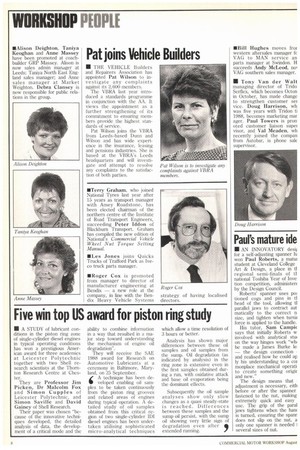Five win top US award for piston ring study
Page 106

If you've noticed an error in this article please click here to report it so we can fix it.
• A sTuDY of lubricant conditions in the piston ring zone of single-cylinder diesel engines in typical operating conditions has won a prestigious American award for three academics at Leicester Polytechnic together with two Shell research scientists at the Thornton Research Centre at Chester.
They are Professor Jim Picken, Dr Malcolm Fox and Simon Cupples of Leicester Polytechnic, and Simon Saville and David Gainey of Shell Research.
Their paper was chosen "because of the innovative techniques developed, the detailed analysis of data, the development of a critical mode and the ability to combine information in a way that resulted in a major step toward understanding the mechanism of engine oil degradation".
They will receive the SAE 1988 award for Research on Automotive Lubricants at a ceremony in Baltimore, Maryland, on 25 September.
, A technique has been de veloped enabling oil samples to be taken continuously from the piston ring grooves and related areas of engines during typical operation. A detailed study of oil samples obtained from this critical region of two single-cylinder IDI diesel engines has been undertaken utilising sophisticated micro-analytical techniques which allow a time resolution of 3 hours or better.
Analysis has shown major differences between these oil samples and oil samples from the sump. Oil degradation (as indicated by analysis) in the ring zone is extensive even in the first samples obtained during a run, with oxidative attack and base oil evaporation being the dominant effects.
Subsequently the oil sample analyses show only slow changes as a quasi steady-state is reached. Differences between these samples and the sump oil persist, with the sump oil showing very little sign of degradation even after extended running.




































































































































